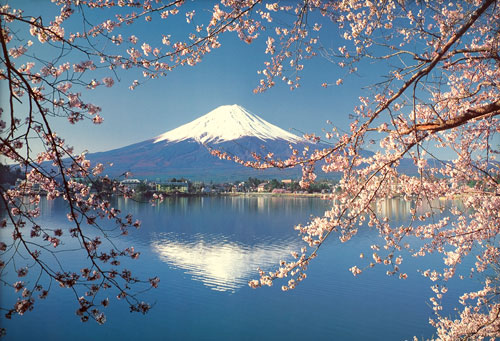Japan, the land of the rising sun

Japan is a country of a unique and original culture. Hieroglyphics which present the name of this country mean “sunrise”, hence “The Land of the Rising Sun”. The first exhibition dedicated to the country neighboring Russia in the East took place in “Raduga” in 2001. To date there have been organized four expositions. Some of them were visited by Japanese delegations headed by the country’s Ambassador to the Russian federation. On March 24, 2008, on the day of its tenth anniversary, the Cultural and Exhibition Centre “Raduga” opened a Japanese Hall with the view of presenting various sides of cultural life of this country.
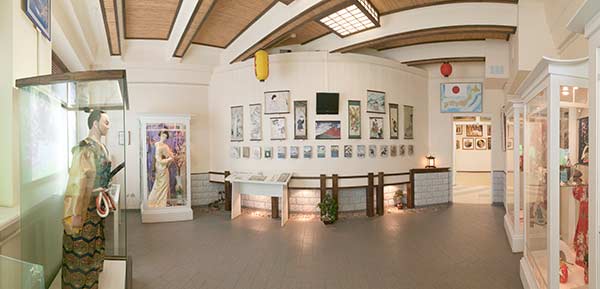
Japan is an island state in Eastern Asia. The geographical location of the country is remarkable for its significant stretch from north-east to south-west which has caused a variety of natural conditions native to the land. The islands are prone to frequent earthquakes and typhoons, but the formidable elements have never caused hostility to nature. People have learned to live in harmony with it. The recognition of the sacred beginning in nature, and the adherence to the family cult of the ancestors are common to all religious traditions. Almost all Japanese profess Shinto, but belong at the same time to one of the numerous Buddhist communities guided in life by the principles of Confucianism. All forms of creativity are subject to the Zen aesthetic concept based on categories of “hidden beauty” and rural simplicity.

Japanese gardens
A Japanese garden is a unique structure. The rock garden, for instance, expresses the idea of the world order, the primordial harmony of the world… The gardens show the people’s creative view of nature and manifest their ability to see its most distinctive details which brought to life the art of bonsai. This art is capable of exciting feelings similar to those awakened by the pictorial skill of an artist. Bonsai is the art of growing dwarf trees. It requires high professional skills and a fine artistic intuition.
Japanese national costume
Kimono (literary karu – “wear”, mono – “thing”) appeared in the VIII century. It has not changed its form ever since. This is a wide, straight robe with a small collar and rectangular sleeves. It has no buckles or pockets and is wrapped around rightwards the same by men and by women. An important article of the traditional kimono is the obi belt. It adds completeness and solidity to the apparel. The belt fits closely to the figure and is tied at the back in an intricate knot or a bow.
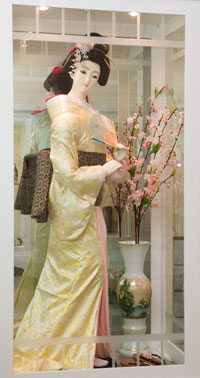
Geta is a kind of the national footwear. They are wooden sandals the same for both feet in the shape of a bench. Nowadays, they are worn when walking for recreation or in an inclement weather.
In Japan, the fan is a symbol of life. The fastening pin is considered to be the beginning of the path, and the divergent rays represent the road of life expanding towards the prosperity in the future. The fans have been used not only for “exciting the air” and “producing the coolness.” Brought once from China, the fan became an essential part of the traditional Japanese costume and then simply a household article that is a convenient and meaningful accessory.
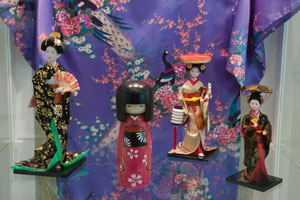
Japanese dolls
Dolls “ningyo” (“human form”) appeared a very long time ago. They are not just a child’s fun, but, first of all, an object of viewing and admiring. The Japanese believe in the ability of dolls to bring good to people, to repel evil forces, maladies, and natural calamities, to preserve peace and quiet in the house.
Armor and weapons of the samurai
As a feudal military estate, the samurai appeared in the X-XI centuries. One hundred years later they became the ruling elite of the country and maintained this status till 1868. The samurai’s weapon is a sword. It is a symbol of a firm, unbending, and perfect spirit. The life and death of the warrior were subject to the law of honour and the samurai duty. Each samurai observed the rule of the Bushido – “The Way of the Warrior” – the moral and ethical code of the behavioural norm.
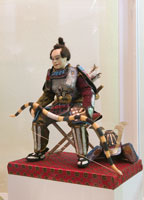 |
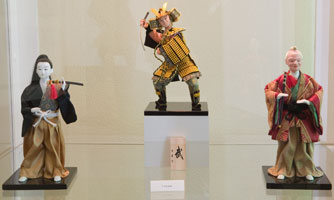 |
Tableware for traditional tea time, for sushi and sake
National features are manifested in all spheres of life and including cooking. Japanese cuisine attracts special attention around the world owing to its peculiar taste and health benefits. One of the most favourite dishes is sushi. Tableware is of great importance, too. It is designed in such a way that one could easily hold it in one hand and the sticks in the other. About one third of the world’s population uses chopsticks.
Sake is rice wine. It can be of different taste, aroma, and transparency. All this depends on the skill of the distillers, the quality of local water and rice. Dishes for sake are also created in a special way.
Tea is an object of art and needs the hand of a master to reveal its noblest qualities. It is the tableware that helps towards giving the tea ceremony a true spirituality. Any tea-set is a perfect gift keeping in itself the warmth and brilliancy of The Land of the Rising Sun. The spirit of the tea ceremony creates an atmosphere of sincerity and makes idle worries and troubles recede into the background. It’s a nice time of friendly talks about beauty…
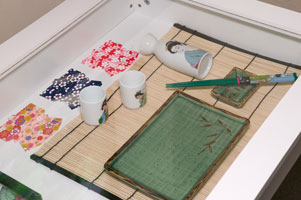
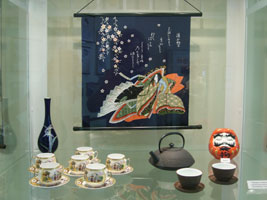
Japanese prints and paintangs
The artistic culture of Japan has developed for many centuries. Over this long time there have been created outstanding works included in the golden collection of world art. Japanese painting is very diverse not only in content but also in forms: these are wall- paintings, picture-screens, album sheets, fans, vertical and horizontal scrolls performed on silk and paper. A cultural accent of The Land of the Rising Sun aims at seeking beauty in all manifestations of material and spiritual life, its peculiar charm, at times subtle and elusive.
One of the areas of fine arts is ukiyo-e. This is a special printing technique, in other words impressions of wooden boards, offering the image of a “swift-flowing world.” Ando Hirosige, an eminent master of engraving, created a series titled “One Hundred Aspects of Edo” and revealed in it lofty wisdom, deep sense, and harmony., Kotsushika Hokusai’s works present an epically wide, majestic image of his native country embodied in a sacred mountain. “Red Fuji” is one of them. Fuji, the highest mountain peak (3776 m), is the symbol of Japan. Admiring the beauty of nature, its inimitable fascination became a distinction of the national character and found its reflection in all forms of art.
